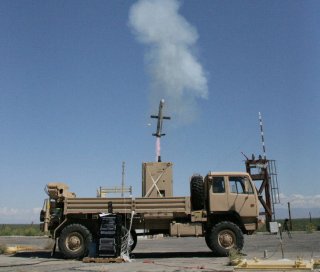by Michael Peck
 Here's What You Need To Remember: For the U.S. military and other potential Chinese adversaries, this is one more advanced weapon that they may encounter in battle. Like drones in general, loitering munitions can be hard to detect and shoot down, especially the smaller models.
Here's What You Need To Remember: For the U.S. military and other potential Chinese adversaries, this is one more advanced weapon that they may encounter in battle. Like drones in general, loitering munitions can be hard to detect and shoot down, especially the smaller models.
China’s military is looking to buy suicide drones.
The military wants two types of suicide drones, according to an announcement posted on a Chinese military procurement Web site. The desired technical specifications of the drones, or the number to be purchased, is classified.
But Chinese drone manufacturers do have products that might satisfy the demands of the People’s Liberation Army. In 2018, China Aerospace unveiled the CH-901, which Chinese media described as being 4 feet long and weighing 20 pounds, with a speed of 150 kilometers (93 miles) per hour, a range of 15 kilometers (9 miles) and an endurance of two hours. The larger WS-43 is a 500-pound weapon with a range of 60 kilometers (37 miles) and an endurance of 30 minutes.
Either expendable attack drones or flying artillery shells, depending on how you look at them, suicide drones are lethal newcomers to the 21st Century battlefield. Called “loitering munitions” by military customers who are understandably reluctant to refer to them as suicidal, these weapons seek to bridge the gap between artillery shells – which can’t stay up in the air – and strike drones like America’s Reaper and Predator, which are big and expensive unmanned aircraft
Loitering munitions feature a propeller, wings, a warhead and a camera. They orbit an area, scanning it with their cameras to identify targets and transmitting the images back to the operator. When the operator sees a worthwhile target, he can command the drone to perform a death-dive on the target.
The potential uses of these weapons are numerous. Aerovision’s Switchblade, which the U.S. Marine Corps ordered in 2018, is a handheld 6-pound weapon that fits inside a soldier’s backpack. Switchblade is designed for situations such as troops encountering a mortar on the reverse slope of a hill that can’t be hit by direct-fire weapons. Instead of waiting for artillery or airstrikes, a rifleman can pluck a Switchblade from his backpack and destroy the target. Or, if hitting a sniper in a building risks collateral damage to civilians, a Switchblade can be flown through the window. Its warhead is no more powerful than that of a grenade, but that’s still powerful enough to take out a mortar or sniper.
Watergate Scandal: The United States House of Representatives Judiciary Committee opens formal and public impeachment hearings against President Nixon.
England and Portugal ratify their alliance with the signing of the Treaty of Windsor, making it the oldest diplomatic alliance in the world which is still in force.
Israel’s Harpy, designed to knock out enemy radar sites, is a much larger weapon. Introduced in 1990 as probably the world’s first suicide drone, the 300-pound Harpy has a range of up to 250 miles and an endurance of two hours. It is similar to a traditional anti-radiation missile that homes in on signals from a radar station. However, unlike a missile, it can stalk an area for hours, waiting for an unwary operator to switch on a radar before it autonomously flies toward the target.
Ironically, China got its first taste of suicide drones when Israel sold it the Harpy in the 1990s, to the displeasure of the U.S. government. Meanwhile, Russia is also developing its own kamikaze drones.
For the U.S. military and other potential Chinese adversaries, this is one more advanced weapon that they may encounter in battle. Like drones in general, loitering munitions can be hard to detect and shoot down, especially the smaller models.
Even worse, those Chinese loitering munitions may be popping up outside of China. Beijing may have become the world’s No. 2 arms exporter, whose aircraft, tanks and rifles can be found across the globe. This means that American soldiers could face Chinese-made suicide drones in hotspots such as Africa and the Middle East.
No comments:
Post a Comment